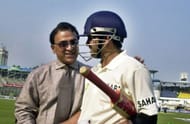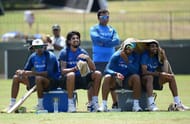India started playing international in 1932. Since then, they have become a major force at the global stage. Comparing the batting legends' contribution towards Indian cricket is a way to look at what's coming next.
In 1971, India toured the Caribbean Islands. The series ended in a way no one thought it would. Sunil Gavaskar, a 21-year-old from Mumbai, debuted in the Test series against the mighty West Indies. No one would have believed that he will score a record 774 runs in those 4 Tests. One man literally changed the course of the series and the Indian side belittled the then giants of cricket. Soon after, Gavaskar became a household name. He kept on piling runs at the Test level. He played Test cricket for 16 years. In those 16 years, he made Indian batting look very strong. The 5 feet 5 inches tall batsman made the fastest and deadliest attacks ineffective against him.
The Indian batting was not among the best in the cricket world at that time. His career gave massive amounts of respect to this side. He broke previous records and set new batting records. He became the first batsman to score 10,000 runs in Test cricket and he had the most centuries by any batsman. With these numbers, there came a lot of attention towards Indian cricket and he had become the face of the sport in the nation.
When Gavaskar retired, the Indians of 1980s were quite convinced that he was the ultimate batsman and no man could go past him. The world thought he was next to Bradman.
A few years later, in 1989, there came Sachin Tendulkar. The teenager took rapid strides in international cricket. 10 years down the line, he had close to 6000 Test runs at an average of 56.70 and over 8500 ODI runs at 42.85. He already had scored 46 international hundreds and had 67 fifties to his name. People started calling him the next Gavaskar. He not only broke his records, but took them to another level. Gavaskar scored 10,122 Test runs while Sachin went on to get 15,921 runs; Gavaskar got 34 Test centuries while Sachin scored 17 more. Also, Gavaskar played for 16 years while Sachin played for 8 more.

Everything that Gavaskar did, Sachin did better. Sachin scored over 34,000 international runs and 100 international centuries. There was again this belief among cricket fans that he was the ultimate batsman and that no man could go past him. People treated Sachin as a part of their family and his retirement day was a national sentiment.
With all the talks about Sachin gone, there was another youngster in line to fill the big boots in the Indian batting lineup, Virat Kohli. Pretty much like the previous two, he had shown glimpses of his flamboyance in the early stages of his career. No Indian fan can forget his 183 against Pakistan and his thrashing of Lasith Malinga in Australia. As his career progressed, his role was pretty much like Sachin's - scoring the major chunk of the runs and taking India through. Gavaskar had the technique, Tendulkar had the technique and the aggression; and Virat has the technique, aggression and the ability to chase well under pressure. Virat has now reached the 15000 run-mark in international cricket in just 10 years.

Given the fitness standards he maintains, his odds of playing for another 10 years are inclined towards the positive. Currently the No. 1 ranked batsman in Tests and ODIs, his batting has constantly improved. His final frontier was the Anderson battle in England against which he has come out with flying colours. Apart from the batting, his captaincy has been a boon to Indian cricket. He proved to be the perfect successor to the legendary MS Dhoni. Virat enjoys a 66.67 winning percentage across all formats as captain.
While Gavaskar brought recognition to Indian cricket, Tendulkar brought the riches and Kohli is bringing style and passion.
India is considered a batting heavy side since the times of Gavaskar. But in the recent past, the subcontinent side has won many matches with their bowling.

In Indian conditions, the spinners pounce on the foreign batsmen and before they realize what is happening, the series has gone to the Indians. In away countries, the Indian 'pace quartet' has made Indian bowling the best they have ever had. There are hardly any Tests where India are comprehensively beaten. If the bowling fails, the batting delivers and vice-versa.
The current Indian team is better than the previous teams based on their performances both home and away. The home record of this side since 2015 has been absolutely flawless. In tough conditions like Australia, South Africa and England, this side has given a tougher competition than what the previous sides had given.
When both the batting and bowling graphs tend upwards, the team has nothing to worry about and everything to cash in on. If nothing goes incredibly awry, there is no stopping Indian cricket from reaching higher summits.
Brand-new app in a brand-new avatar! Download Cric Rocket for fast cricket scores, rocket flicks, super notifications and much more!
